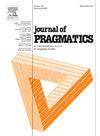Responding with ‘really’ in Korean conversation
IF 1.7
1区 文学
0 LANGUAGE & LINGUISTICS
引用次数: 0
Abstract
This study examines two responses both glossed as the English newsmark really in Korean: 진짜 cincca and 진짜야 cincca-ya, which are among the most prevalent ways of responding to news in Korean conversational data. The structural distinction between the two forms is the attachment of copula -ya ‘be’ to the noun cincca ‘real’. At a glance, they appear interchangeable. However, a closer investigation of the sequential and interactional environments in which they emerge shows that they implement separate action formats that pursue different responses, resulting in divergent interactional trajectories. Cincca-ya treats the information as a matter that requires further verification from the news deliverer, thereby questioning and problematizing the validity of the informing and mobilizing confirmation and an account. In contrast, cincca displays that the information is new or significant in some way but does not necessarily make confirmation relevant, as the information is accepted as is. We argue that the addition of the copula transforms cinnca, a particle response, into a minimal clausal response, which allows the response format to carry out a distinct action. Overall, this study contributes to our understanding of how responses to informing are constructed across languages with data from Korean.
在韩语对话中用“真的”来回应
本研究考察了两种反应,这两种反应都被伪装成韩语中的英语新闻标记:“金甲”和“金甲”,这两种反应是韩语会话数据中最普遍的对新闻的反应方式。这两种形式在结构上的区别是copula -ya“be”与名词cincca“real”的连接。乍一看,它们似乎是可以互换的。然而,对它们出现的顺序和交互环境进行更深入的调查表明,它们实现了追求不同响应的单独动作格式,导致了不同的交互轨迹。cinccya将信息视为需要新闻发布者进一步核实的事项,从而质疑和质疑通知和动员确认和帐户的有效性。相比之下,cinca在某种程度上显示信息是新的或重要的,但不一定使确认相关,因为信息是按原样接受的。我们认为,copula的加入将cinca(粒子响应)转化为最小子句响应,从而允许响应格式执行不同的动作。总的来说,这项研究有助于我们理解如何通过韩语的数据跨语言构建对信息的反应。
本文章由计算机程序翻译,如有差异,请以英文原文为准。
求助全文
约1分钟内获得全文
求助全文
来源期刊

Journal of Pragmatics
Multiple-
CiteScore
3.90
自引率
18.80%
发文量
219
期刊介绍:
Since 1977, the Journal of Pragmatics has provided a forum for bringing together a wide range of research in pragmatics, including cognitive pragmatics, corpus pragmatics, experimental pragmatics, historical pragmatics, interpersonal pragmatics, multimodal pragmatics, sociopragmatics, theoretical pragmatics and related fields. Our aim is to publish innovative pragmatic scholarship from all perspectives, which contributes to theories of how speakers produce and interpret language in different contexts drawing on attested data from a wide range of languages/cultures in different parts of the world. The Journal of Pragmatics also encourages work that uses attested language data to explore the relationship between pragmatics and neighbouring research areas such as semantics, discourse analysis, conversation analysis and ethnomethodology, interactional linguistics, sociolinguistics, linguistic anthropology, media studies, psychology, sociology, and the philosophy of language. Alongside full-length articles, discussion notes and book reviews, the journal welcomes proposals for high quality special issues in all areas of pragmatics which make a significant contribution to a topical or developing area at the cutting-edge of research.
 求助内容:
求助内容: 应助结果提醒方式:
应助结果提醒方式:


